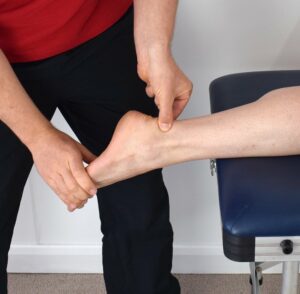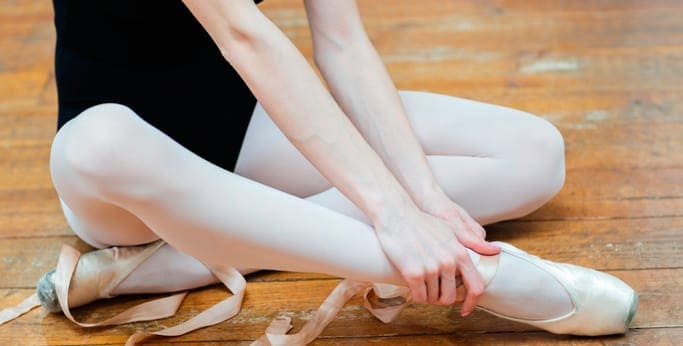Dancers are some of the most physically fit people on the planet. They require extreme flexibility, strength, and endurance to perform their art. However, this athleticism also puts dancers at risk for ankle injuries. In this blog post, we will discuss the 5 most common ankle injuries in dancers – and how you can prevent them!
Contents
Ankle Injuries In Dancers

Dancers are constantly at high risk for ankle injuries. With the risk of turning or rolling an ankle during a leap or jump, it’s important to be aware of the most common ankle injuries dancers experience – and how to prevent them.
Sometimes referred to as a “sprained ankle,” an ankle sprain is one of the most common injuries among dancers. This happens when the ligaments that support the ankle are stretched or torn.
Ankle fractures are also common in dancers. This happens when there is a break in one or more of the bones that make up the ankle joint.
Dancers are also susceptible to Achilles tendonitis, which is an inflammation of the Achilles tendon – the large tendon that connects the calf muscle to the heel bone. This injury is often caused by overuse or repetitive stress on the tendon.
They can have a major impact on a dancer’s ability to continue dancing and may even lead to retirement from the activity.
The Six Most Common Ankle Injuries in Dancers

Having a basic understanding of the most common ankle injuries can help dancers take steps to prevent them.
Sprained Ankles
The most common ankle injury among dancers is a sprain. This occurs when the ligaments that support the ankle are stretched or torn. A sprained ankle can range from a mild injury that heals quickly with home treatment, to a more severe injury that requires immobilization and professional medical care. These sprained ankles are also susceptible to re-injury.
Fractured Ankles
Dancers are also at risk of fracturing their ankles. This happens when there is a break in one or more of the bones that make up the ankle joint. A fracture can range from a small crack to a complete break. It can also involve the bones, ligaments, and tendons around the ankle joint. A fractured ankle is a serious injury that requires professional medical care and may require surgery to heal properly.
Achilles Tendonitis
Dancers are also susceptible to Achilles tendonitis, which is an inflammation of the Achilles tendon – the large tendon that connects the calf muscle to the heel bone. This injury is often caused by overuse or repetitive stress on the tendon. Achilles tendonitis can range from a mild injury that heals with home treatment, to a more severe injury that requires professional medical care and may even lead to retirement from dancing.
Posterior Ankle Impingement
Another common ankle injury among dancers is posterior ankle impingement. This occurs when the tendons or bones in the back of the ankle are pinched or compressed. This can happen when the foot is forcefully pointed or when the dancer lands awkwardly from a jump. Posterior ankle impingement can range from a mild injury that heals with home treatment, to a more severe injury that requires professional medical care.
Stress Fractures
Sometimes, dancers can develop stress fractures in the bones of their feet and ankles. This happens when the bone is overloaded with repetitive stress and begins to crack. Stress fractures are most common in the metatarsals – the bones in the middle of the foot. These fractures can range from a small crack to a complete break. They can also involve the ligaments, tendons, and muscles around the fracture site. Stress fractures are serious injuries that require professional medical care and may require surgery to heal properly.
FHL Tendinopathy
An injury that is specific to dancers is FHL tendinopathy. This occurs when the flexor hallucis longus (FHL) tendon – the tendon that attaches the big toe to the foot – becomes damaged. This injury is often caused by overuse or repetitive stress on the tendon. FHL tendinopathy can range from a mild injury that heals with home treatment, to a more severe injury that requires professional medical care and may even lead to retirement from dancing.
Preventing Ankle Injuries in Dancers

There are several things that dancers can do to prevent ankle injuries. These include:
Warming Up Slowly and Thoroughly Before Dancing
One of the most common causes of ankle injuries is dancing without properly warming up first. This can cause the muscles and tendons around the ankle to be tighter and less flexible, which can lead to strains and other injuries. To prevent this, dancers should always warm up slowly and thoroughly before dancing. Sometimes, gentle stretching and light aerobic activity, such as walking or jogging, can also help to prevent injuries.
Wearing The Proper Footwear
Another important way to prevent ankle injuries is to wear the proper footwear. This means shoes that fit well and provide adequate support for the foot and ankle. Dancers should also avoid wearing high heels or other shoes with skinny heels, as these can put extra stress on the ankles and feet. These types of shoes are more likely to cause ankle sprains, strains, and other injuries.
Using Proper Technique
It is also important for dancers to use proper technique when dancing. This means using the correct form and alignment for each move. Dancers should also be careful not to over-extend their range of motion, as this can put extra stress on the ankles and feet.
Listening To Your Body
Also, dancers need to listen to their bodies. This means being aware of any pain or discomfort that they are feeling. If a dancer is experiencing any pain or discomfort, they should stop dancing and seek professional medical care. By listening to their bodies, dancers can help to prevent minor injuries from becoming more serious.
Taking breaks
Dancers need to take breaks when they are tired or feel pain in their feet or ankles. This will help to prevent overuse injuries and allow the body to rest and heal. Sometimes, dancers may need to take a few days or even weeks off from dancing to allow an injury to heal properly.
Cross-Training
Dancers should also consider cross-training – meaning, participating in other activities besides dancing. This can help to strengthen the muscles and tendons around the ankle, which can help to prevent injuries. Some good cross-training activities for dancers include swimming, yoga, and Pilates.
Avoid Overtraining
Sometimes, dancers may be tempted to push themselves too hard to improve their skills. However, this can lead to injuries. Overtraining can cause the muscles and tendons around the ankle to become overworked and inflamed, which can lead to strains, sprains, and other injuries. To avoid overtraining, dancers should make sure to take breaks when they are tired and listen to their bodies if they are experiencing any pain or discomfort.
Get Professional Medical Care
If a dancer does experience an ankle injury, it is important to seek professional medical care as soon as possible. This will help to ensure that the injury heals properly and does not become worse. Sometimes, ankle injuries may require surgery or other forms of treatment to heal
It may also be necessary for dancers to take a break from dancing while they recover from an injury. This can help to prevent the injury from becoming worse and allow the body to rest and heal.
Stay Hydrated
Ankle injuries can also be caused by dehydration. This is because dehydration can lead to cramping, which can put extra stress on the muscles and tendons around the ankle. To prevent this, dancers should make sure to stay hydrated by drinking plenty of water before, during, and after dance rehearsals and performances. Also, avoid drinking alcohol or caffeinated beverages, as these can lead to dehydration.
Stretch Regularly
Stretching is also an important part of injury prevention. Dancers should stretch slowly and carefully before and after dancing. They should also avoid bouncing or jerking movements, as this can lead to strains or other injuries. By stretching regularly, dancers can help to keep their muscles and tendons around the ankle healthy and strong, which can help to prevent injuries.
Conclusion
Ankle injuries are a common occurrence in dancers. While some of these injuries are due to overuse or poor technique, others occur from accidents or falls. The best way to prevent ankle injuries is to warm up properly before dancing, use proper technique when dancing, and pay attention to any pain or discomfort that you may be feeling. If you do experience an ankle injury, it is important to seek medical help immediately and follow the instructions given to you by your doctor to avoid further injury.
While ankle injuries can be serious, most dancers recover fully with the proper treatment and care. With this in mind, don’t let a fear of an injury stop you from enjoying the wonderful art of dance.
Physical Therapy help patients recover from pain. If you’re experiencing Back pain, Shoulder pain, Knee pain, Neck pain, Elbow pain, Hip pain, or Arthritis pain, a physical therapist at MantraCare can help: Book a physiotherapy session.


